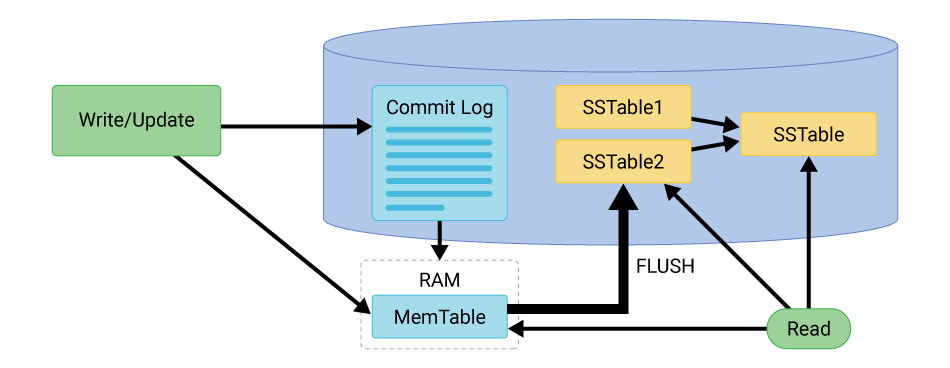Cassandra Memtable FAQs
What is Memtable in Cassandra?
Here’s how Cassandra Memtables work:
Write operations are first written to the Cassandra Memtable structure rather than directly to disk. This speeds write operations since writing to memory is much quicker.
Recently written data is held in memory, organized in a Cassandra Memtable data structure optimized for faster reads and writes. There it remains until it exceeds the configured Cassandra Memtable size or triggers a flush.
Cassandra Commitlog, Memtable, SSTable: How Do They Compare?
Commitlog, Memtable, and SSTable are important components of Cassandra architecture used to manage data persistence, durability, and different aspects of performance. Commitlog ensures data durability, SSTables provide the on-disk storage format for persisted data, and Cassandra Memtable optimizes write performance.
What is Commitlog in Cassandra?
Commitlog is a recovery mechanism used to ensure data durability in case of node failure or crash. Every write path operation in Cassandra is written to the Commitlog as well as the Memtable. Memtables are later flushed to SSTables.
It’s important to configure sufficient segments of commitlog total space in MB to accommodate write operations and ensure data availability under any conditions.
What is the difference between Cassandra Memtable and SSTable?
The Memtable and SSTable in Cassandra are closely related. As described elsewhere, the Memtable serves as an in-memory write-back cache for recent write operations. It flushes data to disk from the Memtable as SSTables when it reaches a threshold.
Sorted string tables (SSTables) are the on-disk storage format Apache Cassandra uses to persist data. SSTables are immutable data structures, meaning that they cannot be modified once they are written.
New SSTables also insert updates and manage deletions. Data storage in SSTables is sorted by keys to enable efficient range queries and retrieval. Over time, SSTables are merged and compacted to optimize disk space and improve performance of read operations.
Cassandra Memtable Flush Frequency
The optimal Cassandra Memtable flush frequency depends on various factors such as workload characteristics, available system resources, and performance requirements:
- Workload characteristics. More frequent Cassandra flush Memtable operations may be beneficial for workloads with a high volume of write operations, to prevent excessive memory consumptions. For workloads with lower write volume, less frequent flushes may be sufficient.
- System resources. Frequent Memtable flushes can consume CPU and disk I/O resources, so it’s essential to consider available memory resources on Cassandra nodes to ensure the system can handle the flush frequency without impacting overall performance.
- Latency requirements. If the application has strict latency requirements, it may be necessary to adjust the Memtable flush frequency to balance write performance and data durability.
The Cassandra Memtable flush nodetool command triggers an immediate flush for a specified keyspace or tables. However, the nodetool drain command can impact write performance, consuming CPU and disk I/O resources. Nodetool flush is commonly used to clear up memory space for new writes.
Does ScyllaDB Offer Solutions for Cassandra Memtable?
ScyllaDB offers wide-column NoSQL database that’s API-compatible with Cassandra and supports CQL. It is known for achieving predictable performance at scale.
ScyllaDB was written from scratch to be compatible with Cassandra while improving on its well-known performance shortcomings. ScyllaDB offers a similar architecture (memtables, SSTables, commitlog, etc.), data format, and query language as Cassandra, but without Java and its expensive GC pauses. Team cite fewer nodes, reduced administration, and lower infrastructure cost as the reasons why they migrated from Cassandra to ScyllaDB.
If you’re curious about Apache Cassandra alternatives, see this detailed ScyllaDB and Cassandra comparison.

